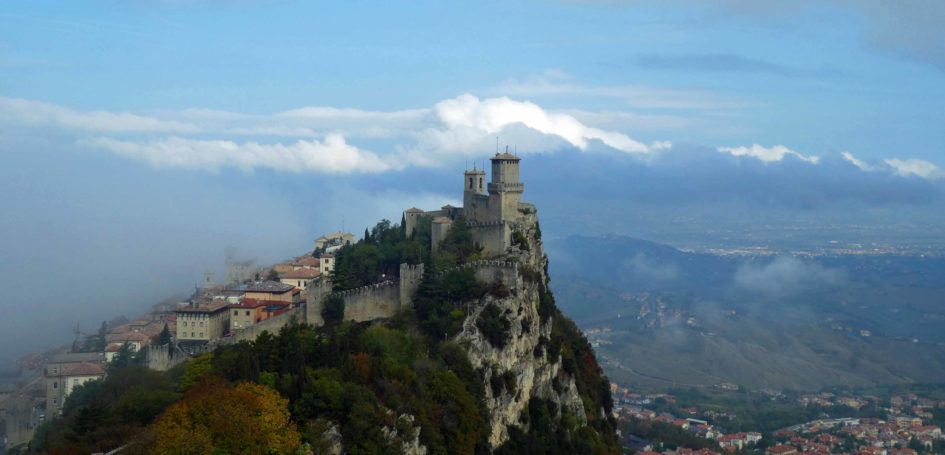When we crossed the border into San Marino we’d been on the road for about an hour and a half on a cold, wet and pretty miserable day. Now our destination was in sight – or it should have been.
 We knew (from Google maps) that Mt Titano was right in front of us; on this day, though, the massive mountain was completely obscured by dense low cloud. But that’s where we were headed, to the top of Mt Titano and the City of San Marino, capital of the fifth smallest country in the world. To get there we had only to negotiate another 5k’s of narrow roads and hairpin bends in pouring rain and with visibility of not more than about 50 metres.
We knew (from Google maps) that Mt Titano was right in front of us; on this day, though, the massive mountain was completely obscured by dense low cloud. But that’s where we were headed, to the top of Mt Titano and the City of San Marino, capital of the fifth smallest country in the world. To get there we had only to negotiate another 5k’s of narrow roads and hairpin bends in pouring rain and with visibility of not more than about 50 metres.
Suffice to say we weren’t disappointed when the little sign for ‘Car Park 6’ appeared suddenly out of the mist. Greg stopped the car and grabbed the bag. Just as we were ready to make a run for cover we noticed a woman close by. It was the parking inspector, standing in the rain, booking the car next to ours. Welcome to San Marino.
 Really that’s being unfair. San Marino is a small and very pretty city, and the Sammarinese people are lovely. (The parking inspector not only gave us directions to the hotel, she also explained that we could get a parking pass from there).
Really that’s being unfair. San Marino is a small and very pretty city, and the Sammarinese people are lovely. (The parking inspector not only gave us directions to the hotel, she also explained that we could get a parking pass from there).
Tourism is a key industry here; with a population of fewer than 34-thousand, San Marino welcomes more than two million visitors each year.  Most come to see The Three Towers, castle-like fortresses standing quite close together on the peaks of Mt Titano. Views from the towers are spectacular and the photograph of the Fortress of Guaita perched atop its peak – with the city on one side and that dramatic drop to the valley on the other – has become the most recognisable image of San Marino.
Most come to see The Three Towers, castle-like fortresses standing quite close together on the peaks of Mt Titano. Views from the towers are spectacular and the photograph of the Fortress of Guaita perched atop its peak – with the city on one side and that dramatic drop to the valley on the other – has become the most recognisable image of San Marino.
This tiny land-locked country is located on the border between the Italian regions of Emilia-Romagna and Marche. Said to have been founded by a Christian stonemason named Marinus in 301, San Marino claims to be the world’s oldest republic.
Every six months the elected parliament selects two of its members to serve as Captains Regent, joint chiefs of state who run the government for that period. It’s a system that’s been in place for almost 800 years.
Here are a few more interesting things about San Marino:
- At just over 61 square kms, it’s Europe’s third smallest country (after Vatican City and Monaco).
- San Marino became a member of the United Nations in 1992 but is not a member of the European Union.
- The country’s unit of currency is the euro and its primary language is Italian.
- The standard of living is high; in international GPD per capita rankings San Marino sits at 13, one spot below Australia and well ahead of Italy.
- Citizenship by birth doesn’t exit, only those who have at least one Sammarinese parent are citizens; and if you want to try for naturalisation you’ll have to wait it out – if you haven’t lived in San Marino for at least 30 years don’t even bother to apply.


10/17/2017 at 1:05 am
Had only heard of the Grand Prix, which wasn’t even held in San Marino!
Such unimaginable beauty.
10/13/2017 at 9:20 pm
What an absolutely stunning country!! I hope you two aren’t thinking of applying for citizenship though, 30 years!! Wow! Hehe
10/11/2017 at 8:39 pm
Wow this looks beautiful! Just so much history it is like a museum or art gallery just walking the streets! You are taking us on an amazing adventure I look forward to your blog updates! Thanks Gayle xx
10/10/2017 at 10:11 pm
On the road already! 😉 I want to know about driving in crazy Italy! You both look amazing! Love!
10/10/2017 at 4:51 am
I just love receiving your updates, so inspiring. I look forward to the day Steve and I can do the same.
10/10/2017 at 12:31 am
Wow. That place looks amazing. Thank you for sharing. And by the way, you both look well. Seems like your new life is really agreeing with you both.
X